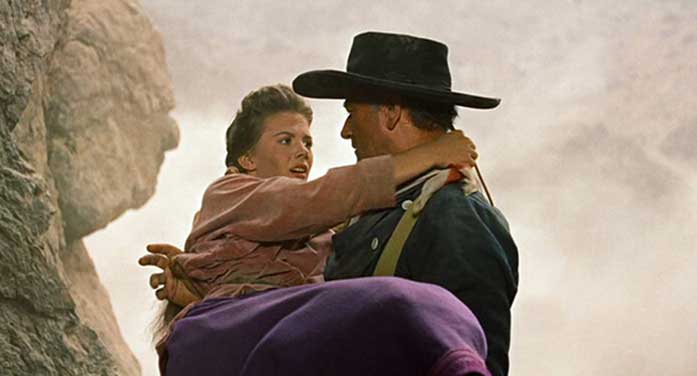 Movie enthusiasts invariably sing the praises of John Ford’s The Searchers. Released in 1956 and starring John Wayne, the film has been described as a masterpiece and shows prominently in critical lists of the best films ever made.
Movie enthusiasts invariably sing the praises of John Ford’s The Searchers. Released in 1956 and starring John Wayne, the film has been described as a masterpiece and shows prominently in critical lists of the best films ever made.
It’s inspired by a true story. Or maybe that should be stories in the plural.
The Searchers was based on a 1954 novel by Alan Le May, who’d researched a number of real-life frontier kidnappings. One of these was the 1836 snatching of nine-year-old Cynthia Ann Parker. Taken in a Comanche raid, she virtually disappeared for 24 years.
The events leading to Cynthia Ann’s kidnapping were set in motion in Mexico City.
Mexico’s enormous territories north of the Rio Grande – all inherited from imperial Spain – were a mixed blessing. Sparsely settled, they were difficult to govern and subject to relentless Comanche raiding.
So the leaders in Mexico City had an idea. American immigrants would be wooed with generous land grants and – thus transformed into loyal Mexican subjects – they’d provide the requisite population base and a bulwark against the Comanche.
The Parkers from Illinois were beneficiaries of this policy, migrating to Texas in 1833.
Between them, several Parker brothers received adjacent land grants of over 16,000 acres and proceeded to build a fortified one-acre fort on the unprotected frontier borderland. Fish and game abounded, and the fertile soil was suitable for farming. It was also, to quote S.C. Gwynne’s Empire of the Summer Moon, “an extremely dangerous place.”
The Comanche, too, were relative newcomers to Texas, although they’d been there for a century or so longer than the Parkers. They’d migrated southward in the late 1600s/early 1700s and became dominant by 1750.
The 16th-century Spanish introduction of the horse was the catalyst for their ascendancy. Fortuitously, it was a relatively small “desert horse” suited to the environment and all plains tribes adopted it. But none mastered the horse culture as effectively as the Comanche. Whether hunting or raiding, a mounted Comanche was a formidable proposition.
Native American tribes standing in the way were brutally pushed aside. Quoting Gwynne again, the Comanche “held sway over some 20 different tribes who had been either conquered, driven off, or reduced to vassal status.” Comanche-Apache enmity was particularly vicious.
In May 1836, a Comanche raiding party showed up at Parker’s fort. The ensuing proceedings were swift and deadly.
Inexplicably, the front gate had been left open while 10 of the 16 able-bodied men were some distance away working the cornfields. Within a half-hour, five men were dead, two women were wounded, and five captives, including three children, were taken. Cynthia Ann and her seven-year-old brother were among them.
The fate of Comanche captives was generally dire but there were some exceptions. Preadolescent children, especially girls, could get relatively lucky, being adopted and assimilated into the tribe. That’s what happened to Cynthia Ann.
Over time, she fully blended in, marrying a war chief and giving birth to three children. We have no reason to believe she wasn’t happy, or at least as happy as someone could be in the harsh conditions of the mid-19th-century frontier. On two occasions, in 1846 and in the early 1850s, she spurned opportunities to leave.
Then, in December 1860, Cynthia Ann’s Comanche world collapsed around her.
Along with her young daughter, she was ‘rescued’ during a skirmish. In reality, for the second time in her life, Cynthia Ann had been captured.
 Handed over to the care and custody of her uncle, she’d no desire to be reintegrated into white society. Culturally and emotionally, she’d become Comanche, which was something white Texans couldn’t relate to.
Handed over to the care and custody of her uncle, she’d no desire to be reintegrated into white society. Culturally and emotionally, she’d become Comanche, which was something white Texans couldn’t relate to.
To them, she was a victim. Surely she’d been traumatized by unspeakable abuse and thus couldn’t know her own mind. No other explanation was comprehensible.
‘Cultural genocide’ is a term much bandied about these days. If we take it seriously – as opposed to deploying it for ideological purposes – then we should see Cynthia Ann as a victim of cultural genocide twice over, first when she was forcibly abducted in 1836 and again when she was ‘rescued’ in 1860.
Of the two, the latter was the bigger burden for her. Regardless of her biological family’s intentions, she’d become a fully formed adult who no longer wanted to be part of their world.
Miserable and alienated, Cynthia Ann died in 1871. Essentially, she was a captive for the last decade of her life.
That, however, isn’t the end of the story. There’ll be another column.
Pat Murphy casts a history buff’s eye at the goings-on in our world. Never cynical – well, perhaps a little bit. For interview requests, click here.
The opinions expressed by our columnists and contributors are theirs alone and do not inherently or expressly reflect the views of our publication.
© Troy Media
Troy Media is an editorial content provider to media outlets and its own hosted community news outlets across Canada.


